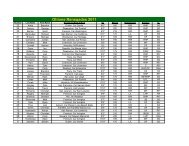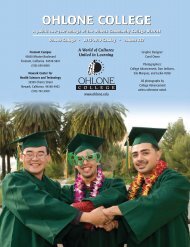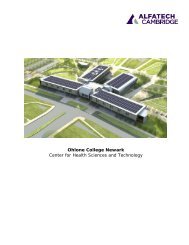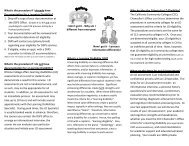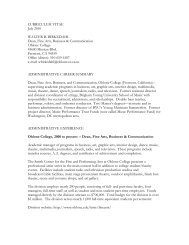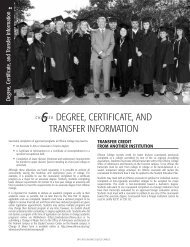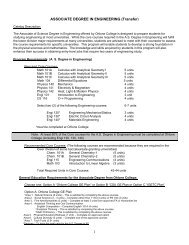2012-2013 Catalog (all pages) - Ohlone College
2012-2013 Catalog (all pages) - Ohlone College
2012-2013 Catalog (all pages) - Ohlone College
You also want an ePaper? Increase the reach of your titles
YUMPU automatically turns print PDFs into web optimized ePapers that Google loves.
152 9 ANNOUNCEMENT OF COURSES<br />
BIOT-121<br />
BIOT-122<br />
BIOT-123<br />
BIOT-131<br />
BIOT-131D<br />
BIOT-131L<br />
Biotechnology Careers<br />
18.00 hrs lecture<br />
Units: 1.00<br />
Advisory: Eligible for ENGL-101A and MATH-151<br />
Accepted For Credit: CSU<br />
This course is designed to offer an in-depth view of the<br />
emerging careers in Biotechnology including agricultural,<br />
environmental, forensics, industrial, pharmaceutical, and<br />
medical biotechnology careers. Students will have an<br />
opportunity to meet many professionals in various<br />
biotechnology positions and to discuss the range of career<br />
options available and educational training required for each<br />
career. Repeatable = 1 time (GR)<br />
Introduction to Nanotechnology<br />
54.00 hrs lecture<br />
Units: 3.00<br />
Accepted For Credit: CSU<br />
Nanotechnology explores exciting potential applications of<br />
science pertaining to tiny structures. Students will be<br />
introduced to fundamentals of biology, chemistry, and<br />
engineering. (GC)<br />
Writing SOPs<br />
9.00 hrs lecture<br />
Units: 0.50<br />
Prerequisite: BIOT-105 or BIOL-101A<br />
Advisory: ENGL-101A<br />
Accepted For Credit: CSU<br />
This is a short training course on the writing of Standard<br />
Operating Procedures (SOPs) for biotechnology. The course<br />
investigates the rational for writing SOPs, and discusses the<br />
standards and regulations that need to be taken into account<br />
in planning SOPs. The course also covers the procedures,<br />
formats, and writing styles employed in writing, implementing,<br />
and evaluating SOPs. (GR)<br />
Computing Concepts in Biotechnology<br />
54.00 hrs lecture, 54.00 hrs lab<br />
Units: 4.00<br />
Cross-referenced Course: CS-131<br />
Accepted For Credit: CSU<br />
This course introduces the basic computing concepts, the most<br />
commonly used computer algorithms, and programming<br />
languages in biotechnology. (GC)<br />
Review of Biotechnology Concepts<br />
18.00 hrs lecture<br />
Units: 1.00<br />
Corequisite: BIOT-106A and/or BIOT-106B and/or BIOT-106M<br />
This course reviews concepts from selected biotechnology<br />
courses. This course also introduces study techniques.<br />
Students’ questions are answered and difficult topics are<br />
clarified; extra drill is provided where needed. (GR)<br />
LAB Learning Community<br />
18.00 hrs lecture<br />
Units: 1.00<br />
Advisory: Student has taken LAB biotechnology or<br />
biochemistry class in high school<br />
Accepted For Credit: CSU<br />
This course is a learning community designed to support the<br />
educational goals of students studying biotechnology or other<br />
STEM fields, especi<strong>all</strong>y those students who have participated in<br />
Learning Alliance for Bioscience biotechnology and/or<br />
biochemistry courses (or equivalent) in high school. Each<br />
semester the course will cover new content and concepts<br />
according to student interests and needs, and new<br />
developments in the field of biotechnology. Repeatable = 3<br />
times (CR)<br />
BIOT-132L<br />
BIOT-133<br />
BIOT-133A<br />
BIOT-141B<br />
BIOT-143<br />
LAB Learning Community, Mentoring Level<br />
18.00 hrs lecture<br />
Units: 1.00<br />
Prerequisite: BIOT-131L<br />
Accepted For Credit: CSU<br />
This course is the second level of a learning community<br />
designed to support the educational goals of students studying<br />
biotechnology or other STEM fields, especi<strong>all</strong>y those students<br />
who have participated in Learning Alliance for Bioscience<br />
biotechnology and/or biochemistry courses (or equivalent) in<br />
high school. Students who have completed three semesters of<br />
the BIOT-131L Learning Community course are eligible to take<br />
this mentor-level class. Each semester the course will cover<br />
new content and concepts according to student interests and<br />
needs, and new developments in the field of biotechnology.<br />
Repeatable = 3 times (CR)<br />
Introduction to SAS Programming<br />
54.00 hrs lecture<br />
Units: 3.00<br />
Cross-referenced Course: CS-133<br />
Accepted For Credit: CSU<br />
The SAS system has become the international standard for<br />
data management, manipulation, storage, retrieval, and<br />
statistical analysis. This course offers an introduction to the SAS<br />
software by using core elements of the SAS system<br />
programming language and procedures. (GR)<br />
Data Analysis Using SAS<br />
54.00 hrs lecture<br />
Units: 3.00<br />
Cross-referenced Course: CS-133A<br />
Prerequisite: BIOT-133 or CS-133<br />
Accepted For Credit: CSU<br />
This course focuses on the following key areas: statistical<br />
inference, analysis of variance, multiple regression, categorical<br />
data analysis, and logistic regression. (GC)<br />
SAS Graphing and ODS<br />
27.00 hrs lecture, 27.00 hrs lab<br />
Units: 2.00<br />
Cross-referenced Course: CS-141B<br />
Advisory: BIOT-133 or CS-133<br />
Accepted For Credit: CSU<br />
This course introduces SAS/GRAPH and ODS. Learn how to<br />
design, construct, and display customized graphs quickly and<br />
efficiently. Learn how to create a data set from the results of<br />
most SAS procedures and build custom reports. Repeatable =<br />
1 time (GC)<br />
Advanced SAS Programming<br />
54.00 hrs lecture<br />
Units: 3.00<br />
Cross-referenced Course: CS-143<br />
Advisory: BIOT-133/CS-133 or some experience in SAS<br />
programming<br />
Accepted For Credit: CSU<br />
This course provides students with a basic understanding of<br />
macro programming and SQL procedure in SAS software. SQL<br />
and macro programming can provide more flexibility and<br />
power in data management and data analysis. (GR)<br />
<strong>2012</strong>-<strong>2013</strong> OHLONE COLLEGE CATALOG






